By Steve Benner for CoinWeek …..
As mentioned in Part 1, Lucania was one of the most important regions of Magna Graecia. Lucania was located in southern Italy, straddling the peninsula between the Gulf of Taranto and the Tyrrhenian Sea (see Figure 1).
This article will first cover the city of Thourioi located on the eastern coast near the border with Bruttium and near the deserted city of Sybaris. Then, switching to the west coast of Lucania, the cities of Laos, Elea, and Poseidonia will be covered, along with some minor cities of Lucania.
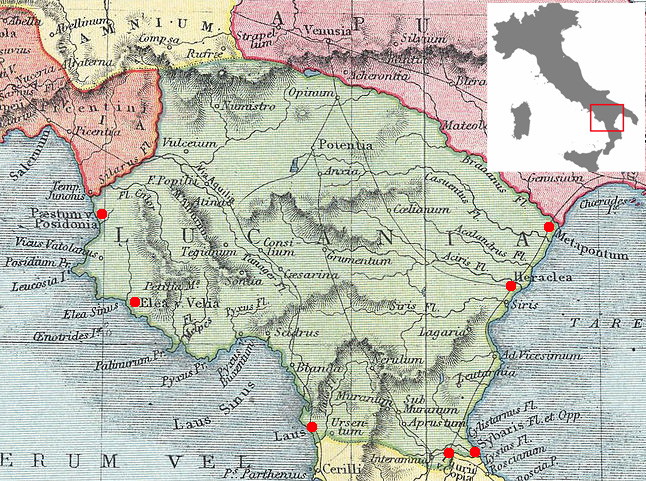
Thourioi (Thurii)
In 443 BCE, after the expulsion of the Krotons and the original Sybarites, the remaining Greeks decided to abandon Sybaris and established a new city, Thourioi, nearby. Its name comes from a spring called “Thuria”. The Thourioians concluded a treaty with Kroton and quickly grew in prosperity, inviting in colonists from the Greek mainland and Magna Graecia. The new city came into conflict with Taranto over the fertile land where Siris had been located (see Heraclea in Part 1). After some inconclusive battles, a compromise succeeded in ending the war and establishing the city of Heraclea.
Late in the Peloponnesian War (431–404 BCE), the citizens of Thourioi were divided over support for the Athenian expedition to Syracuse, but in 413 they opted to furnish Demosthenes with 700 hoplites and 300 dartmen. The city continued to prosper over the next two decades. In 393, Thourioi joined Elea, Hipponion, Kroton, Kaulonia, Metapontum, Pandosia, and Rhegion in an Italiote League to oppose threats by the Lucanians, the Bruttians, and Dionysos I of Syracuse.
In 390, the Lucanians inflicted a devastating defeat on the Thourioi army. This increased the pressure on the city, and it was unable to recover its prosperity.
By 356, the rise of the Bruttians completed the decline of Thourioi.
Not much is heard again from the city, until 282 BCE when the Roman consul, Gaius Fabricius Luseinus, came to their aid and defeated the Lucanians. However, the Tarentines then attacked the city and, after a siege, plundered Thourioi. This act prompted the Romans to declare war on Taranto in 282. After this, Thourioi became a Roman protectorate with garrison troops.
During the Second Punic War (218–201 BCE), the city joined Hannibal after Cannae, but Hannibal let his soldiers plunder the city when he had to return to Carthage in 204. The city was selected as a Roman colony with Latin rights in 194. It was renamed Copiae, but the name did not stick. The city was eventually abandoned during the Middle Ages.
Thourioi began striking silver coins on the Achaian standard of 7.9 grams to the nomos or didrachm in the second half of the fifth century. The city struck distaters, didrachms, drachms, triobols, trihemiobols, diobols, and pentetartemorions (this unusual denomination was worth 1.25 obol). By the fourth century, the city only struck distaters, didrachms, and triobols. The influence of Sybaris is clearly visible on the coin types, usually the head of Athena obverse and a bull walking or charging reverse (Figure 2). This is the same type seen in Group IV of Sybaris (Figure 13 in Part 1). The city name, ΘOYPIΩN, is above the bull.
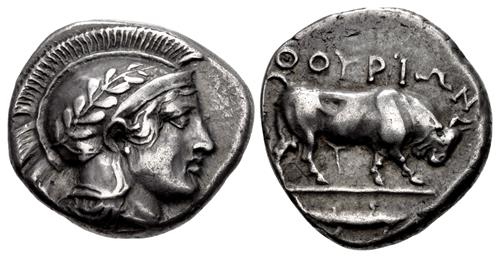
At the beginning of the third century BCE, the city changed to the Taranto standard of 6.6 grams to the didrachm. The types remained essentially the same though Athena sometimes wears a Corinthian helmet and Apollo’s head sometimes replaces Athena’s (Figure 3).
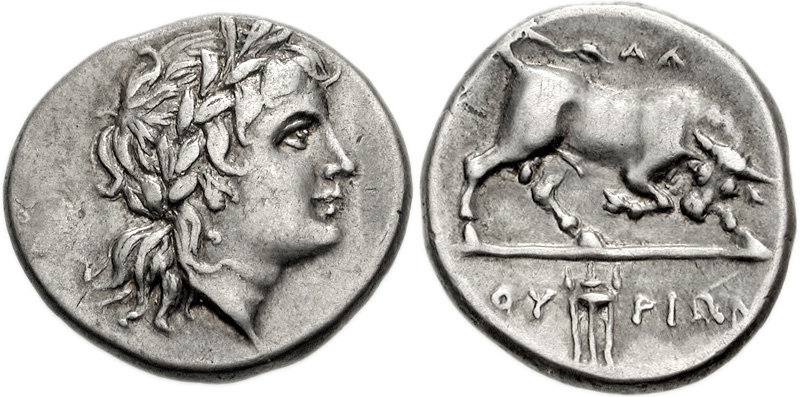
Bronze coins of group C (2.6-5.22 g.) were struck beginning in the fifth century BCE. The style was the same as the silver coins. Groups B (5.8-10.3 g.), D (2.6-5.22 g.), and E (0.37-1.6 g.) were added soon after. In the early fourth century, the bronze types were reduced to only B, C, and D, but, by mid-century, groups AA (25.39-28.88 g.) and A (12.05-15.38 g.) replaced all the previous groups. In the third century, denominations B, C, D, and E returned, and AA was dropped. New types were introduced that included the heads of Apollo and Artemis and their respective attributes (Figure 4). One “A” coin was modeled on Bruttium coinage with a Zeus obverse and eagle reverse, and one “C” coin had the head of Demeter, possibly reflecting the influence of the Punic goddess Tanit during the Second Punic war.

Laos (Laus)
Laos was located on the west coast of Lucania near the Bruttium border at the mouth of the Lao River. It was a colony of Sybaris founded in the seventh century BCE. After Sybaris’ destruction in 510, most of Laos’ inhabitants were refugees from the destroyed city. It was near Laos that the Lucanians inflicted a devastating defeat upon the Thourioi army in 390 (see above). Otherwise very little is known of its history.
Coinage of Laos is rare and sporadic. The silver issues were minted during the fifth century BCE and included denominations ranging from nomoi to diobols. The larger silver coins had a man-headed bull (Achelous?) on both sides (Figure 5), and the fractions had the same obverse and a reverse of either a man-headed bull, an acorn, or pellets in a circle (Figure 6). The city name was shown as ΛAS, either forward or retrograde.
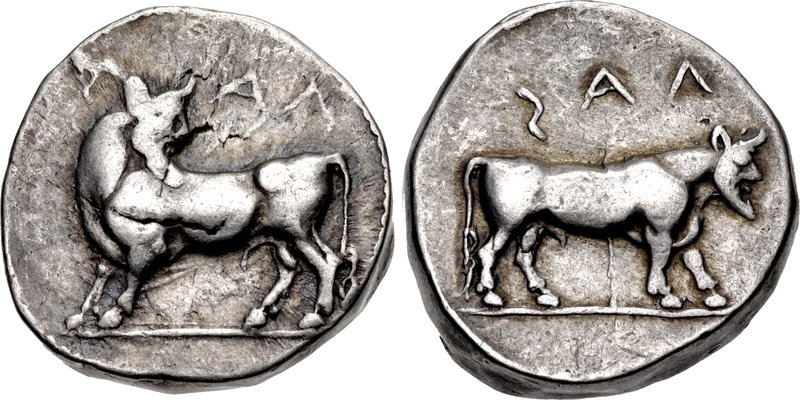

The bronze coinage was minted in the fourth century and probably consisted of two denominations: “light” and “heavy”. The types were more diverse than the silver, having the head of a deity (Demeter, Athena, Dionysus, or Herakles) or a man-headed bull on the obverse and one or two birds on the reverse (Figure 7).
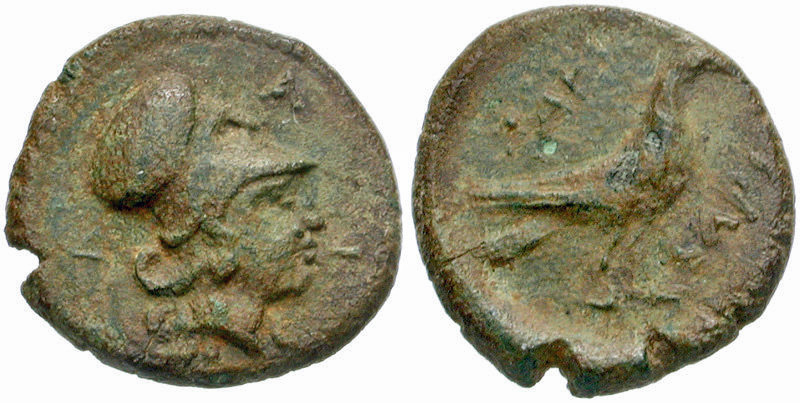
Elea (Velia)
Elea is located about two-thirds of the way up the Tyrrhenian coast from Bruttium. It was founded in 535 on the coast between two rivers by Phokaean colonists, who had fled their Corsican colony due to Carthaginian and Etruscan pressure. It became prosperous from trading and fishing and maintained a close relationship with Massalia, another Phokaean colony.
Elea was home to the famous Eleatic School of philosophy led by Parmenides and Zeno in the late sixth and fifth centuries BCE. The colony joined the Italiote League for help in successfully resisting Lucanian incursions, and its lack of fertile land may have led to clashes with Poseidonia. These conflicts led to the building of a circuit wall and fortified acropolis. Elea’s urban area contained a theater and temples to Poseidon Asphaleios and Zeus Polieus. In the early third century, Elea became a staunch Roman ally and changed its name to Velia. The city provided help to Rome during the Second Punic War and was granted full Roman citizenship in 90.
Elea began minting silver coins to the Phokaic standard of 8.0 g to the didrachm in the late sixth century BCE. The initial series included drachms, diobols, obols, and hemiobols, and used the forepart of a lion devouring its prey obverse and incuse punch reverse (Figure 8). The obverse is similar to coins struck by Phokaea in Ionia. In the early fifth century, staters with the head of the nymph Hyele on the obverse and a lion on the reverse were introduced, and the drachms and fractions now had an Hyele obverse and an owl reverse. Early in the 4th century, the drachms were discontinued, and, on the staters, Hyele was replaced by Athena and a reverse with a lion attacking a stag was added (Figure 9). Elean silver coinage stopped being minted after the Pyrrhic War (280-275). The issuing authority on the coins was “the Hyeletans,” ΥΕΛΗΤΩΝ, and a few of the staters have been signed by their engraver.
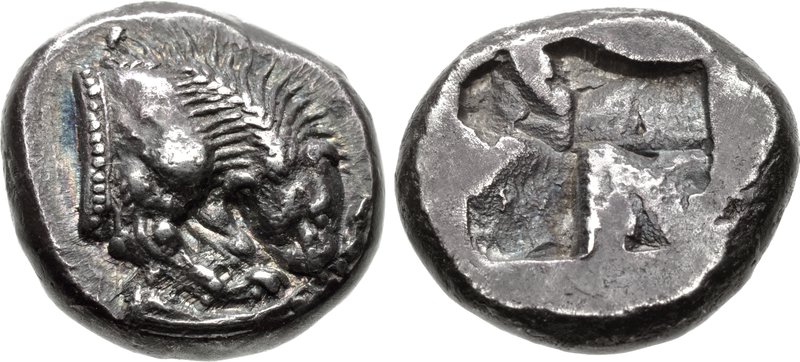
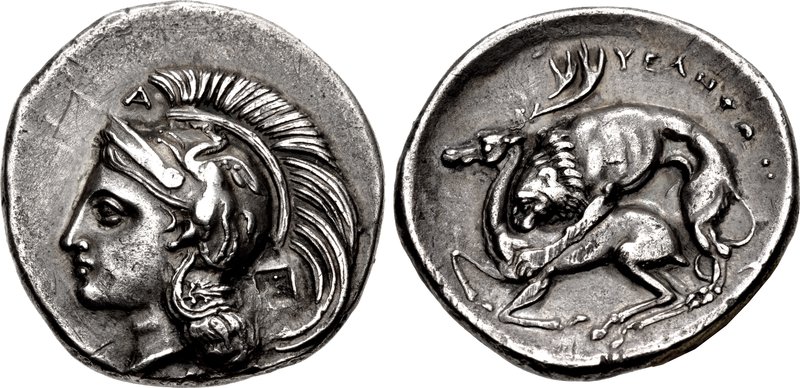
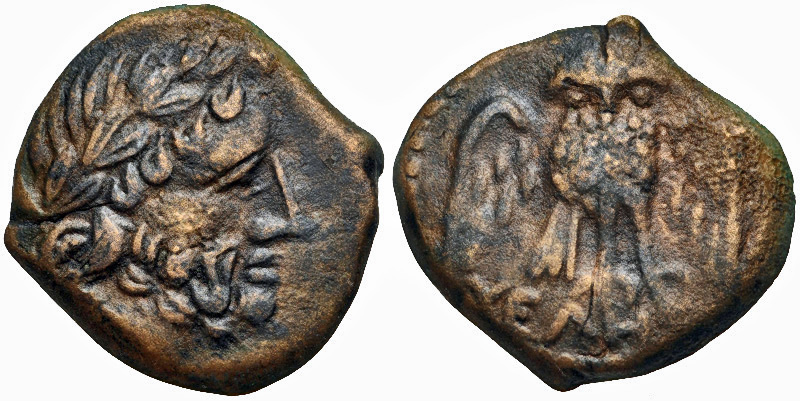
Poseidonia (Paestum)
Poseidonia was founded by Sybaris around 600 on the Lucanian west coast near the border with Campania. The city prospered from its favorable location for trade and the fertility of its surrounding plains. Inside its circuit wall, Poseidonia built three impressive Doric temples dedicated to Hera and Athena and a sanctuary of Demeter.
By 540, the colony was being pressured by Lucanians, so it joined in alliance with Sybaris and friendly Italic tribes. Many exiles from Sybaris settled in the city when that city fell in 510. Late in the fifth or early in the fourth century, the Lucanians conquered the city, renaming it Paistos. It was briefly freed by Alexander I in 332 but returned to Lucanian rule by 330.
During the Pyrrhic War, the city fell under Roman control and, in 273, was refounded as a Roman colony with Latin rights, being renamed Paestum. Paestum opposed Hannibal during the Second Punic War and even provided ships for the recapture of Taranto from the Carthaginians. It was granted full Roman citizenship in 90 and became a municipium.
Like many of the Greek colonies in Lucania, Poseidonia began minting silver coins near the end of the sixth century BCE. And, like the coins of Sybaris, these initial coins used the technique of a raised design obverse and matching incuse reverse on a large flan. In this case, the design was Poseidon brandishing a trident (Figure 11). The coins were struck to a local standard of 7.5 grams to the didrachm and included staters, drachms, obols, and hemiobols. The latter two denominations did not use the raised/incuse technique. The obols have a Poseidon running obverse and legend reverse, and the hemiobols the head of Poseidon obverse and legend reverse.
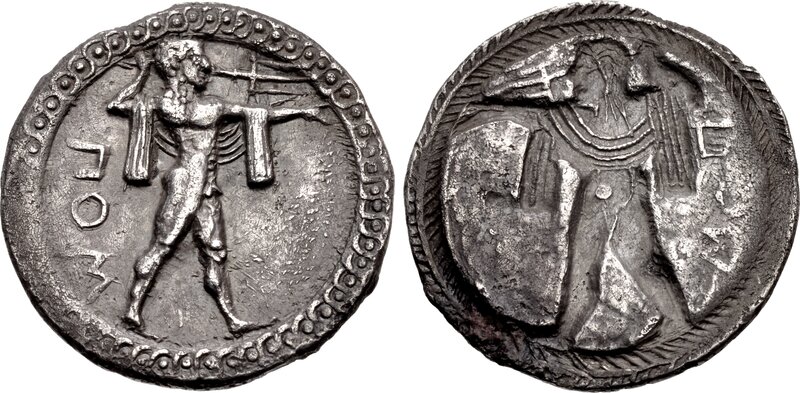
By around 500, the silver coins changed to a raised design on both sides and a fatter flan. The common design was still Poseidon brandishing a trident on the obverse but now a bull was added to the reverse (Figure 12). On the obol, the bull is sometimes replaced by a wheel, and on the hemiobols, a variety of types were used, including the head of Poseidon or Athena, the forepart of a bull, a wheel, or a trident. Some of the coins must have been produced under Lucanian rule, but the celators were probably the same Greeks that had made them before.
The coins carry the city name in a variety of spellings, such as ΠΟΜ, ΠΟΜΕ, ΠΟΜΕΙ, ΠΟΜΕΙΔΑΝΙΑ, etc. and can be either regular or retrograde [in some cases, an epichoric (local) alphabet is used that replaces san (M) with sigma (Σ)]. Also, in the second half of the fifth century BCE, the city minted a gold quarter stater to the Attic standard of 8.6 grams to the stater, probably during the conflict with the Lucanians. This coin has Poseidon welding his trident on the obverse and a bull on the reverse. This coin is extremely rare.
As Paestum, the colony minted silver staters in the third century to the Campanian standard of 7.3 grams to the didrachm. These may have been minted in response to the need for cash during the Pyrrhic and Punic Wars. The coins had the head of Apollo on the obverse and the Dioscuri on the reverse.
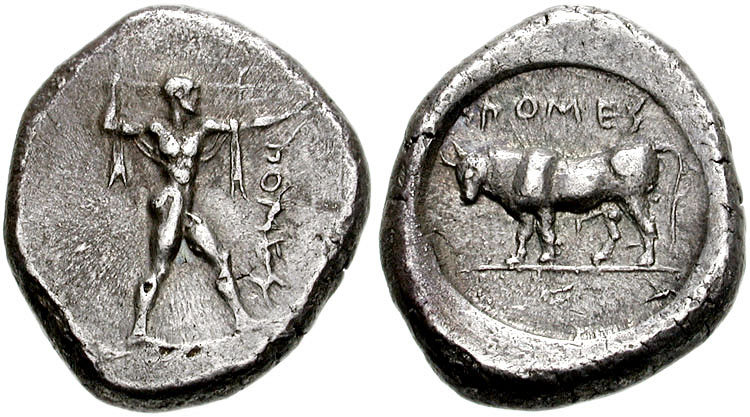
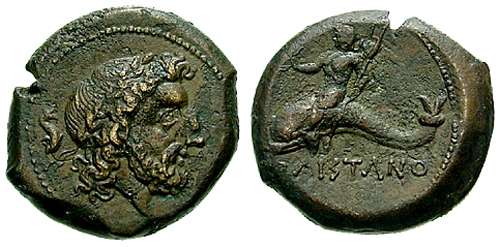
Conclusion
In addition to the coins discussed above, there are some very rare coins minted in the name of Ami, Siris (not the Ionic colony), Pyxous, and So. These staters and drachms are identical to the early raised/incuse bull coins of Sybaris. However, very little is known of the cities’ coins themselves. From 209 to 204 BCE, the Lucanians tribes minted a series of silver drachms and bronze coins to the Punic standard in support of Hannibal. These coins are like the coins struck by the Bruttians during the Second Punic War.
Hopefully, this two-part article has shown that the silver coins minted by the Greek colonies of Lucania can be very attractive. Of course, some can be expensive (see Figure 11), but usually nice examples can be obtained at reasonable prices. In contrast, only a few gold coins were minted by the colonies, and they tend to be very expensive. The bronze coins come in a wide range of styles, conditions, weights, appeal, and cost.
* * *
About the Author
Steve M. Benner has a Ph.D. in engineering from the Ohio State University and worked for NASA at the Goddard Space Flight Center in Greenbelt, Maryland, for almost three decades before retiring in 2016. He has been an ancient coin collector since the early 1970s and is a member of the ANS, the ANA, and the ACCG. He specializes in coins of the ancient Greek leagues and in Roman Imperial bronzes. Dr. Benner has published over 30 ancient coin articles in various publications and is the author of Achaian League Coinage of the 3rd through 1st Centuries B.C.E. (2008) and History and Coinage of the Ancient Greek Leagues, 5th through 1st Centuries B.C.E. (2018).




